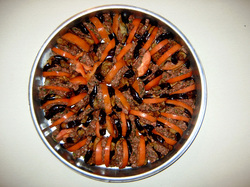Food History
Mesopotamia's richness in food always attracted its poorer neighbors.
Mesopotamia has a very rough history, one that is in a pattern of penetration
and invasion.Mesopotamia, even though one of the most advanced areas of the
time, was very susceptible to the power of its enemies. The river valleys and
plains of Mesopotamia were open to attack from the rivers, the northern and
eastern hills, and the Arabian Desert and Syrian steppe to the west. Despite
all of the troubles and challenges that Mesopotamia faced, it was strong and
prevailed through the many hard times that it faced for many centuries.
A common crop that was grown annually in Mesopotamia was flax. Flax was used
by the Mesopotamians in the production of nets, cloth, linseed oil, meal, and
even many pharmaceuticals. Flax played a very important role in Mesopotamian
agriculture and commerce as a result of its many uses. Another very popular
food source for the Mesopotamians were the two rivers that surrounded the
ancient land. From the Tigris and Euphrates the Mesopotamians were able to pull
many different types of fish and other aquatic animals, and wildfowl of all
sorts could be found in the wet marshes that bordered both of the rivers.
Date palms were also a very important food source to the Mesopotamians. These
palms grew in southern Mesopotamia by the river marshes and supplied fibers,
fodder, wood, and rich food. Products from these palms were very important to
Mesopotamian trade and help make Mesopotamia a very rich and powerful leader in
international trade.
Even though Mesopotamia was for the most part very dry and hot, the Tigris
and the Euphrates irrigated the soil on its banks and produced a lot of very
fertile soil that was used to grow many other types of crops. Some of these
other crops included leeks, onions, lentils, wheat, and barley. Each of these
crops were readily available to the Mesopotamians and were consumed at a very
common rate. As well as leeks, lentils, and other types of crops, many spices,
herbs, and fruits such as the fig were available. Grapes were also very
important to the Mesopotamians and were used in the production of wine. The
olive tree, which was native to the Mesopotamian area, was very useful as well.
It was valued throughout Mesopotamia and its surrounding areas for its oil
which was used to make medicines, perfume bases, lamp fuel, and most of all for
cooking.
The Mesopotamians made good use of the resources that were available to them
and were very productive. The growth and trade of the food in the area
contributed a lot to this productiveness and help Mesopotamia to become a very
powerful leader.
Mesopotamia has a very rough history, one that is in a pattern of penetration
and invasion.Mesopotamia, even though one of the most advanced areas of the
time, was very susceptible to the power of its enemies. The river valleys and
plains of Mesopotamia were open to attack from the rivers, the northern and
eastern hills, and the Arabian Desert and Syrian steppe to the west. Despite
all of the troubles and challenges that Mesopotamia faced, it was strong and
prevailed through the many hard times that it faced for many centuries.
A common crop that was grown annually in Mesopotamia was flax. Flax was used
by the Mesopotamians in the production of nets, cloth, linseed oil, meal, and
even many pharmaceuticals. Flax played a very important role in Mesopotamian
agriculture and commerce as a result of its many uses. Another very popular
food source for the Mesopotamians were the two rivers that surrounded the
ancient land. From the Tigris and Euphrates the Mesopotamians were able to pull
many different types of fish and other aquatic animals, and wildfowl of all
sorts could be found in the wet marshes that bordered both of the rivers.
Date palms were also a very important food source to the Mesopotamians. These
palms grew in southern Mesopotamia by the river marshes and supplied fibers,
fodder, wood, and rich food. Products from these palms were very important to
Mesopotamian trade and help make Mesopotamia a very rich and powerful leader in
international trade.
Even though Mesopotamia was for the most part very dry and hot, the Tigris
and the Euphrates irrigated the soil on its banks and produced a lot of very
fertile soil that was used to grow many other types of crops. Some of these
other crops included leeks, onions, lentils, wheat, and barley. Each of these
crops were readily available to the Mesopotamians and were consumed at a very
common rate. As well as leeks, lentils, and other types of crops, many spices,
herbs, and fruits such as the fig were available. Grapes were also very
important to the Mesopotamians and were used in the production of wine. The
olive tree, which was native to the Mesopotamian area, was very useful as well.
It was valued throughout Mesopotamia and its surrounding areas for its oil
which was used to make medicines, perfume bases, lamp fuel, and most of all for
cooking.
The Mesopotamians made good use of the resources that were available to them
and were very productive. The growth and trade of the food in the area
contributed a lot to this productiveness and help Mesopotamia to become a very
powerful leader.

